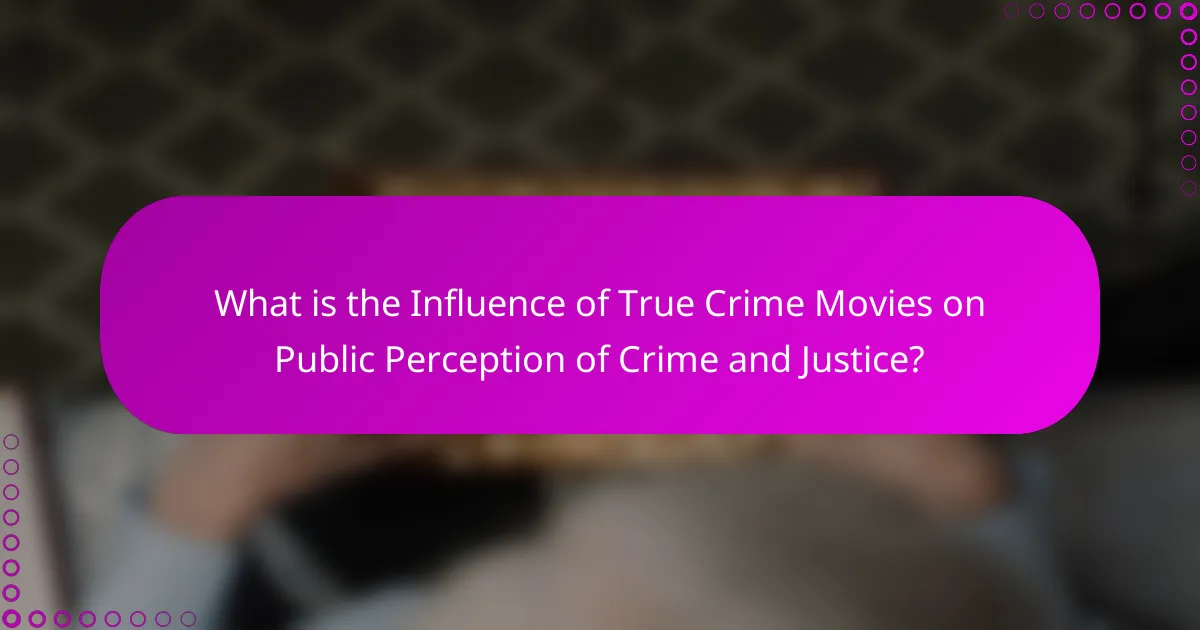True crime movies are films that dramatize real-life criminal cases, significantly influencing public perception of crime and justice. These films often lead to misconceptions about crime rates and the justice system, as research indicates that viewers may overestimate the prevalence of violent crime after watching them. Additionally, true crime narratives can create biases against certain demographics, portraying them as more likely to commit crimes. This skewed representation not only affects societal attitudes but also has the potential to influence public policy and law enforcement practices. Overall, true crime movies play a crucial role in shaping perceptions that may not align with actual statistical realities.

What is the Influence of True Crime Movies on Public Perception of Crime and Justice?
True crime movies significantly shape public perception of crime and justice. They often dramatize real-life cases, influencing viewers’ understanding of criminal behavior. Research indicates that these films can lead to misconceptions about crime rates and the justice system. For instance, studies show that audiences may overestimate the prevalence of violent crime after viewing such content. Additionally, true crime narratives can create biases towards certain demographics, portraying them as more likely to commit crimes. This skewed representation affects societal attitudes and can influence public policy and law enforcement practices. Overall, true crime movies play a crucial role in shaping perceptions that may not align with statistical realities.
How do true crime movies shape viewers’ understanding of crime?
True crime movies shape viewers’ understanding of crime by dramatizing real-life events and presenting them in a narrative format. These films often emphasize certain aspects of crime, such as motives, methods, and consequences. This dramatization can lead to a heightened awareness of criminal behavior and its societal impacts.
Research indicates that viewers may develop skewed perceptions of crime rates based on the prevalence of violent crime depicted in these films. For instance, a study by the University of Pennsylvania found that audiences often overestimate the frequency of violent crime after viewing true crime content.
Additionally, true crime movies can influence public opinion on justice systems and law enforcement. They frequently highlight flaws in investigations or legal proceedings, which can lead viewers to question the efficacy of these systems. Overall, true crime films play a significant role in shaping societal narratives about crime and justice.
What specific elements in true crime movies contribute to this understanding?
True crime movies contribute to understanding public perception of crime through various specific elements. These elements include dramatized narratives that engage viewers emotionally. They often feature real-life cases, which add authenticity and relatability. The use of expert commentary provides context and analysis, enhancing credibility. Visual storytelling techniques, such as reenactments, create a vivid representation of events. Additionally, character development allows audiences to empathize with victims and perpetrators. The incorporation of statistics and crime data offers factual grounding to the narratives. Finally, the exploration of societal issues, like justice system flaws, prompts critical thinking among viewers.
How do narrative techniques in true crime films affect audience perception?
Narrative techniques in true crime films significantly shape audience perception. These techniques include storytelling methods, character development, and emotional engagement. For example, a nonlinear narrative can create suspense and intrigue, drawing viewers deeper into the story. Character framing influences how audiences empathize with victims or perceive perpetrators. Emotional appeals, such as music and visuals, enhance the emotional impact of the narrative. Research shows that these techniques can lead to heightened fear of crime and skewed perceptions of justice. A study by Fisher and Womack (2019) found that viewers often overestimate the prevalence of violent crime after watching dramatized true crime content. This indicates that narrative techniques not only engage viewers but also affect their understanding of real-world crime dynamics.
Why are true crime movies popular among audiences?
True crime movies are popular among audiences due to their compelling storytelling and psychological intrigue. They provide a glimpse into real-life criminal cases, which fascinates viewers. Audiences are often drawn to the mystery and suspense surrounding these stories. The emotional connection to the victims and the quest for justice resonate deeply with many. Additionally, true crime films often explore moral dilemmas and societal issues. This can lead to discussions about crime and justice in society. Research indicates that approximately 30% of adults in the U.S. watch true crime content regularly. This popularity reflects a broader cultural interest in understanding the darker aspects of human behavior.
What psychological factors drive the fascination with true crime stories?
The fascination with true crime stories is driven by several psychological factors. One key factor is the human desire for understanding and control over fear. True crime narratives allow individuals to explore dark themes in a safe environment. This exploration can provide a sense of catharsis and relief from everyday stress.
Additionally, the thrill associated with danger and the unknown can be appealing. Engaging with true crime stories activates the brain’s reward system, releasing dopamine. This biochemical response reinforces the enjoyment of suspense and intrigue.
Moreover, empathy plays a significant role. Many people are drawn to the emotional experiences of victims and their families. This connection can lead to increased compassion and a desire for justice.
Research shows that true crime consumption can also fulfill a need for social bonding. Discussing these stories can foster connections between individuals. Thus, the psychological factors driving fascination with true crime encompass fear management, thrill-seeking, empathy, and social interaction.
How does cultural context influence the popularity of true crime films?
Cultural context significantly influences the popularity of true crime films. Different societies have varying levels of interest in crime narratives based on historical, social, and psychological factors. For instance, in cultures with high crime rates, true crime films often resonate more due to personal relevance. Additionally, cultural taboos and norms shape how audiences perceive crime and justice. Countries with strong legal systems may focus more on procedural aspects, while those with systemic issues may highlight injustice. According to a study by the Pew Research Center, 60% of Americans express interest in true crime stories, reflecting a cultural fascination with crime and morality. This trend shows how cultural context shapes viewer engagement and interest in true crime narratives.
What impact do true crime movies have on societal views of justice?
True crime movies significantly shape societal views of justice. They often portray the criminal justice system as flawed and biased. Viewers may develop skepticism towards police and legal outcomes. Research indicates that exposure to such narratives can lead to a heightened awareness of wrongful convictions. For example, a study by the University of Southern California found that viewers of true crime shows are more likely to believe in the prevalence of miscarriages of justice. Additionally, these films can influence public opinion on crime policies. They may generate calls for reform or increased scrutiny of law enforcement practices. Overall, true crime movies play a crucial role in shaping perceptions of justice and accountability in society.
How do these films influence opinions about law enforcement and the legal system?
True crime films significantly shape public opinions about law enforcement and the legal system. These films often dramatize real events, leading viewers to form perceptions based on emotional storytelling rather than factual accuracy. For instance, they frequently depict law enforcement as either heroic figures or corrupt agents, which can sway audience sentiments in either direction. Research indicates that repeated exposure to certain narratives can reinforce stereotypes about police effectiveness and justice outcomes. A study by the American Psychological Association found that media portrayals can lead to distorted beliefs about crime rates and the likelihood of wrongful convictions. Thus, true crime films play a pivotal role in influencing societal views on crime and justice.
In what ways do true crime movies affect public trust in the justice system?
True crime movies can negatively impact public trust in the justice system. They often portray law enforcement as ineffective or corrupt. This portrayal can lead to skepticism about the system’s ability to deliver justice. Viewers may develop a sense of distrust based on dramatizations that exaggerate flaws. Research indicates that frequent exposure to these films correlates with a diminished belief in the fairness of legal proceedings. For example, a study by the American Psychological Association found that audiences who watch true crime shows are more likely to believe in wrongful convictions. These narratives can create a perception that the justice system is unreliable. Consequently, public confidence in law enforcement and judicial processes may decline.
How do true crime movies affect individual perceptions of safety?
True crime movies often heighten individual perceptions of safety by portraying crime as more prevalent and dangerous than it may be in reality. Viewers may develop an exaggerated fear of becoming victims based on the dramatic narratives presented. Research indicates that frequent exposure to crime-related media can lead to increased anxiety and a skewed understanding of crime statistics. For example, a study published in the journal “Psychology of Popular Media Culture” found that individuals who consume more true crime content tend to overestimate their personal risk of victimization. This effect can lead to changes in behavior, such as avoiding certain areas or increasing personal security measures. Overall, true crime movies shape viewers’ perceptions by influencing their understanding of crime and personal safety.
What role does sensationalism play in shaping fears and concerns about crime?
Sensationalism significantly amplifies public fears and concerns about crime. It distorts the reality of crime statistics and often portrays violent incidents as more frequent than they are. Media coverage tends to focus on extreme cases, creating a perception that crime is rampant. This selective reporting can lead to heightened anxiety among the public, influencing their views on safety and security. Research indicates that sensationalized crime stories can increase fear, even in communities where crime rates are declining. For example, a study published in the “Journal of Communication” found a correlation between sensationalist media coverage and increased public fear of crime. Thus, sensationalism plays a crucial role in shaping societal perceptions of crime.
How do personal experiences intersect with narratives presented in true crime films?
Personal experiences intersect with narratives in true crime films by shaping viewer perceptions and emotional responses. Audiences often relate to the victims or perpetrators based on their own life experiences. This connection can intensify the impact of the film’s narrative. Research shows that personal backgrounds influence how people interpret crime stories. For instance, individuals who have experienced trauma may respond more strongly to certain portrayals. True crime films often reflect societal fears and personal anxieties, making them resonate deeply. This intersection can affect public understanding of crime and justice, as viewers may generalize their experiences to broader societal issues.
What are the ethical considerations surrounding true crime movies?
True crime movies raise several ethical considerations. They often exploit real-life tragedies for entertainment. This can lead to victimization of the affected families. The portrayal of events may lack accuracy and sensitivity. It can also perpetuate stereotypes about crime and criminals. Furthermore, these films can influence public perception of justice. They may create misconceptions about the legal system. Ethical filmmaking should prioritize respect for victims and their families.
How do filmmakers balance entertainment with responsible storytelling?
Filmmakers balance entertainment with responsible storytelling by integrating factual accuracy with engaging narratives. They conduct thorough research to ensure that the stories reflect real events and perspectives. This approach not only maintains viewer interest but also respects the subjects involved. For instance, many true crime films consult with experts or utilize primary sources to enhance authenticity. Additionally, filmmakers often include disclaimers to clarify dramatization versus factual content. This practice helps manage audience expectations and promotes critical thinking. By prioritizing ethical considerations, filmmakers can entertain while fostering a deeper understanding of complex issues.
What responsibilities do creators have towards the victims and their families?
Creators have a responsibility to portray victims and their families with sensitivity and accuracy. They should ensure that the narratives do not exploit the trauma experienced by these individuals. Creators must prioritize the dignity of victims by avoiding sensationalism in their storytelling. They should also seek consent from families when possible, respecting their wishes regarding how their loved ones are represented. Additionally, creators should provide context to avoid misinterpretation of events. Ethical considerations in true crime storytelling are essential to maintain respect for the affected parties. Ultimately, responsible creators contribute to a more informed and compassionate public perception of crime and justice.
How can viewers critically engage with true crime movies?
Viewers can critically engage with true crime movies by analyzing the storytelling techniques used. They should examine how narratives are constructed and what perspectives are presented. Viewers can also assess the accuracy of the depicted events. Fact-checking against reliable sources is essential for understanding the truth behind the dramatization.
Additionally, viewers should reflect on the ethical implications of true crime storytelling. This includes considering how victims and their families are portrayed. Engaging with discussions on the societal impact of these films can further enhance critical analysis. Research indicates that true crime media can shape public perceptions of crime and justice, influencing attitudes toward the criminal justice system.
By questioning the motives behind the production of these films, viewers can gain deeper insights into their cultural significance.
What strategies can audiences use to differentiate fact from fiction in true crime narratives?
Audiences can differentiate fact from fiction in true crime narratives by critically analyzing the source material. They should seek out original court documents and police reports related to the case. This primary evidence provides factual insights into the events. Audiences can also compare multiple sources, such as books, documentaries, and news articles, to identify discrepancies. Fact-checking websites can be valuable for verifying claims made in narratives. Engaging with expert analyses from criminologists or legal professionals can further clarify the accuracy of the portrayal. Additionally, audiences should be aware of dramatizations that may embellish or alter facts for entertainment purposes. Understanding the difference between narrative techniques and actual events is crucial in assessing the authenticity of true crime stories.
The main entity of this article is true crime movies, which significantly influence public perception of crime and justice. The article explores how these films shape viewers’ understanding of criminal behavior, often leading to misconceptions about crime rates and biases towards certain demographics. It discusses specific elements and narrative techniques that contribute to these perceptions, the psychological factors driving audience fascination, and the cultural context influencing their popularity. Additionally, the article examines the impact of true crime narratives on societal views of justice, public trust in the legal system, and individual perceptions of safety, while addressing ethical considerations and the responsibilities of filmmakers.


